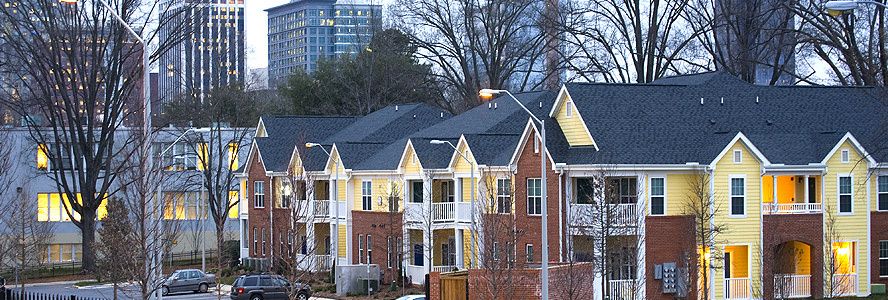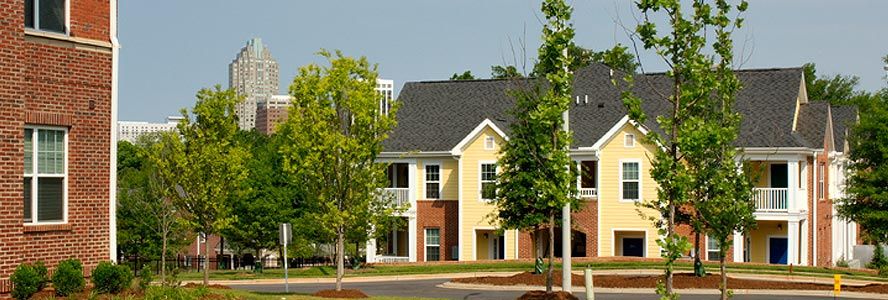I watched the demo and beginning of the build (I was on the BOD of a non-profit adjacent to that land) and couldn’t believe it. I also lived in Pilot Mill for 7 years adjacent to Capitol park and I have to tell you that I think that is a good example of affordable housing. The community is well-kept, it has decent density, and they have pretty stringent rules that are enforced. People that live there are proud.
Capital Park is a much better example, I agree.
However, if the city is prioritizing quantity of units, then they need to look at all possibilities. Right now, with Capital Park and Walnut Terrace being so “new”, the real opportunity to be creative with land use is at Heritage Park. There’s a lot of possibilities on that parcel. Instead of harassing developers who have purchased their own land at market rates, look inward at what you can do to maximize your land assets and provide more housing.
I’ll add that, if residents not having a personal car is the motivating factor for providing more affordable housing within the core of the city, then stop prioritizing cars in the site plans of the projects and build more units. If it’s presumed that everyone has a car that lives there, then the argument to provide the affordable housing within walking distance/bus service to the lower paid downtown jobs falls apart. Pick one.
I’m not sure if they already do but why doesn’t the city make those 6 story “luxury” apartment buildings going up around NCSU include affordable housing instead of forcing it upon developers like Kane to include housing in their large scale projects? If so is there a crippling shortage that needs immediate attention or is it a political stunt for more votes?
We also can’t forget about the same giant mistake of land use without mentioning the 2009ish remodel of Chavis Heights. Even their website picture makes you upset at the waste of affordable housing potential so close to downtown. These are next to Ligon Middle School off Lenoir St. if anyone is curious, again this is not something you can force on future developers who want to build 40 story housing on 1/2 acre land.
Yep. That’s another example. Who’s making these unsound decisions for 2 story buildings? I just Google mapped it and, my God, all that parking!!!
I walk by there a couple times a week, and at most 1/3 of the entire parking lot is ever used.
The bus stop out front on the other hand is used A LOT.
To be fair you can fix Chavis Height by progressively updating small sections of it for increased density bit by bit.
Select an apartment block, wait until every leaser leaves tear it down and build a denser building with a lot more units in its place.
That actually a solid plan if they went with that as the city doesn’t have to buy more expensive land just pay for newer buildings.
But that is too smart…
All I can say is that whenever they redevelop Heritage Park, they better get it right.
That site is developed at about 10 units per acre, if I recall, which means a mere 122 units across 12 contiguous acres.
Current zoning is RX-3 which is stupid and completely inadequate. This is 3 blocks from Fayetteville Street and 3 blocks from Union Station (once West Street is connected) for crying out loud.
The site, however, is huge - and with appropriate zoning could easily accommodate 10x that in a simple stick built mid rise format with 7 story zoning entitlement. 20x would probably be possible with 12 stories.
If a redevelopment doesn’t have minimum of 1000 units, then I will have to ask, wtf are we even doing? I think that any redevelopment should be a combination of increasing the number of income restricted units, while also adding a whole bunch of market rate units as well.
The first step towards redeveloping would be for RHA to rezone the property. At minimum, go RX-7 on the west half and DX-12 on the east half.
Redeveloping Heritage Park can’t come soon enough:
“Just shove as many people into the smallest place possible” is what a lot of this sounds like. There are reasons for the more suburban and less dense styles of public housing. Not everything is done just to maximize space, there are social factors and other issues that go into the construction of these sites. There was a move away from the large form subsidized housing because the lent themselves to poorer outcomes for the residents, which lead to greater issues for cities.
I agree totally. Every large scale affordable housing projects I have ever seen were what everybody called “slums”.
I wish I could find the article/study I read ( I haven’t looked all that hard for it tbh) but basically giving people more of a sense of ownership over their housing leads to better outcomes. So having a home feel more like a home. Is that ideal, density-wise/resource-wise? Probably not but there are trade offs in anything that you’re going to build. In an ideal world, you wouldn’t need subsidized housing of course but an ideal world ain’t walking through that door.
I was just about to comment that it seems we got off topic a bit (as with any conversation). I can think of a dozen other threads covering topics geographically closer to Heritage Park. LOL
Maybe slide over to the South Street Condos thread, or Fairweather, or Southern Gateway, or…affordable housing. 
Certainly many large urban areas (NYC, Chic) have torn down a number of high rise public housing units that had just become crime infested nightmares for the families living there. “Warehousing” the poor is not a good solution. The push for the less dense housing was, I believe, an effort to create housing and homes that were more familiar to most folks. Less density, better for knowing your neighbors and more pride of place leading to less crime and more success in education and economic advancement. But as is so often the case, there isn’t a “one size fits all” solution here. While I think the idea behind the new Chavis Heights was good, clearly there are to many parking spots and not enough density for a place so close to downtown. My belief is the solution will be found in the middle, a mix of higher rises - 4 & 5 stories - with townhomes and even single story buildings, at least as far as public housing goes.
How to get private developers building entry-level and affordable homes is a more difficult question. Cutting red tape and allowing for greater density is one part of the answer. So is new building techniques. CNBC did a story on Clayton Homes - I believe a NC company but now owned by Berkshire Hathaway - famous for mobile homes, bringing their prefabrication process to housing. The FHA is now going to finance these “pre-fab” houses, a change because they’ve the manufacturing style is so close to a trailers. That might help nationally solve part of the low-cost housing crisis. For many cities that will require a change in zoning laws.
My bad too! This should go to affordable housing. We aren’t doing a very good job keeping our threads straight!!
In Cary they used to require traffic studies at site plan which made the road improvements an administratively imposed, required component of site plan approval. This was based on the need to improve roads to provide adequate access to schools. The State addressed it and determined that it was a form of coercion and made it illegal to make those improvements site plan requirements. Cary moved those requirements to the rezoning process where they become conditions that are “freely offered” by the developer. The big problem I have with this is that Cary requires you to use one of their two approved traffic consultants, and you pay the Town to do this “voluntary” study. I have seen situations where a developer pays $35,000 to the Town for a traffic study for their rezoning, and then hires another traffic consultant to represent their interest and refute the results of the Town required traffic study.
If they can get away with that I don’t see any reason Raleigh couldn’t extort affordable housing commitments from developers seeking a rezoning.
I’d love to see more affordable housing, but if they want to do it through zoning they need to create zoning overlays for it. If there’s going to be an overlay applied to an area there would be public hearings, reports, meetings, and a comment period before it gets adopted. The whole city would get to weigh in on a strategy rather than leaving it up to 7 individuals who are only there for 2 years at a time. The overlay could have different criteria for different areas of the city, including areas that are completely exempt, and if a developer wanted to change something to eliminate affordable housing entirely they would need to include that in a rezoning petition. If there was an overlay requiring a percentage of AH then at least the property owners would know what they were dealing with and could plan for it. This could be part of a comprehensive plan where a developer could possibly contribute to an AH fund to meet their AH requirement. The reactionary process we have now with councilmen throwing darts at projects just creates uncertainty and is in no way a plan to deal with AH. It’s just a chance for campaign points.
I think every new residential project in Downtown should have at least 20% affordable housing. Also 35% of the suppliers and contractors shall be women or minority owned. Also 50% of the energy shall come for solar or renewable sources, or an equivalent carbon credit paid to the city. Roofs and ground surfaces shall be grass or other permeable materials and rain water shall be collected and recycled.
Bus stations shall be provided by the developer and shall be climate controlled and free wi-fi provided. (/jk)
True enough. The reconstructions also happened in a world VERY different from when they were 1st constructed as well!! Though I believe the racial mix might still reflect the early mandated segregation when the originals were built.
Can you delete your post and add it here?
To be clear, I am not advocating to “shove as many people…”, but the evidence is striking when you just look at it. IMO, providing suburban type development in a context where market rate housing is provided more densely is bad policy. If we want to prioritize a suburban type affordable housing solution for whatever reason, then move it to a more appropriate context.
I’ll add that, if a developer assembled 27 acres at the location of Walnut Terrace, and built this sparsely for wealthy buyers, I’d be livid. I mean, really, we sit on this site daily and bemoan 5 story “Texas Donuts” that provide way more housing than any of these affordable units per acre.
IMO, it’s insane for the city to push a narrative about needing more affordable housing downtown when their own actions do not reflect efforts commensurate with that narrative.
Density in and of itself is not the problem. If it were the problem, we’d have no high density housing in this country. Then again, it comes as no surprise that density was blamed as we are still fighting the presumption that suburbia is the answer to every question.

